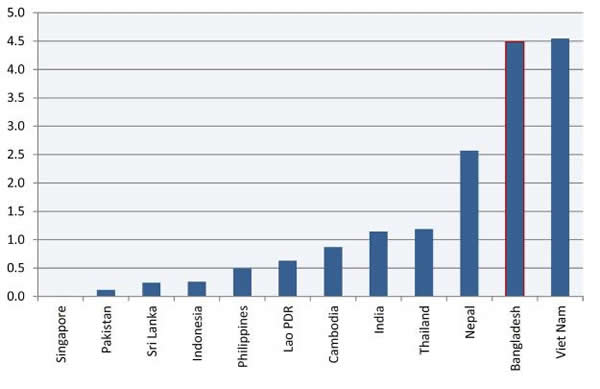When I arrived at Shah Jalal InternationalAirport in Dhaka on a recent trip, I could not help but notice the hundreds of Bangladeshi migrants returning from abroad, clutching their many over-packed bags – no doubt filled with gifts for relatives. Their look of pride at having found prosperity was hard to miss.
Throughout history, people have left their homes in search of a decent job and a better life, often travelling vast distances and facing daunting obstacles. Bangladeshis are no different – the lure of a better economic future has led to comparatively high emigration rates, with many drawn to the construction sector in the Middle East.
In fact, the intention to migrate among Bangladeshi youth is the highest in South Asia and is also higher than in most South East Asian countries. A 2011 survey shows that 35 per cent of Bangladeshis aged 15-24 want to move permanently abroad.
Young people’s intention to migrate permanently to another country, 2011

Young people’s intention to migrate permanently to another country, 2011
Source: Gallup World Poll, 2012.
Despite impressive GDP per capita growth in recent years, formal job creation remains weak while informal jobs and underemployment are common in Bangladesh. The annual flow of Bangladeshis in search of employment overseas has increased fourfold – from around 248,000 in 1999-2000 to more than 980,000 in 2007-2008. This increase was driven largely by demand for less-skilled workers in the Gulf countries.
Bangladesh is one of the largest recipients of remittances, which in 2010 amounted to more than 10 per cent of the country’s GDP, or close to US$ 11 billion. Remittances flowing into Bangladesh have increased more than fivefold between 1999-2000 and 2009-2010.
On average, a Bangladeshi migrant sends home approximately US$2,760 a year, with low skilled workers sending the largest amount.
Remittances have played an important role in reducing poverty and aiding economic development in Bangladesh. They have also proven to be one of the most resilient sources of capital, and are more stable than other macroeconomic variables.
But the joy on the faces of returning migrants masks the financial hardships that many have endured to go abroad, and the working conditions they faced once there. Bangladeshi migrants pay some of the highest recruiting fees in the region – the average cost per person wishing to work abroad is 4.5 times higher than the GDP per capita of Bangladesh.
In the host countries, migrants often face abuse in the form of late payment, pay that is below the minimum wage, lack of social protection and benefits, and deplorable working conditions.
It is the prospect of higher earnings – and, in many cases, any earnings at all – that lures Bangladeshis abroad, despite the hardships they face.
While the appeal of a better income will never fade, it is important for the government to make it attractive to work in Bangladesh, prevent abuse by the recruiting agencies, and ensure better working conditions while abroad. Most importantly, migration should be viewed as a complement not a substitute to development.
Cost of migration: ratio of cost per person and GDP per capita

This article is based on a forthcoming study on Bangladesh as a part of the series entitled Studies on Growth with Equity by the International Institute for Labour Studies.
fecha |
Título |
26/08/2013| |
|
05/06/2013| |
|
05/06/2013| |
|
04/05/2013| |
|
17/04/2013| |
|
17/02/2013| |
|
08/02/2013| |
|
08/02/2013| |
|
01/11/2012| |
|
01/11/2012| |
|
31/10/2012| |
|
31/10/2012| |
|
30/10/2012| |
|
30/10/2012| |
|
30/10/2012| |
|
30/10/2012| |
|
24/10/2012| |
|
24/10/2012| |
|
29/08/2012| |
|
29/08/2012| |
|
29/08/2012| |
|
21/08/2012| |
|
12/08/2012| |
|
12/08/2012| |
|
28/06/2012| |
|
24/06/2012| |
|
24/06/2012| |
|
12/03/2012| |
|
12/03/2012| |
|
12/03/2012| |
|
12/03/2012| |
|
03/03/2012| |
|
03/03/2012| |
|
03/03/2012| |
|
03/03/2012| |
|
17/02/2012| |
|
11/10/2011| |
|
11/10/2011| |
|
09/10/2011| |
|
09/10/2011| |
|
21/09/2011| |
|
20/09/2011| |
|
12/09/2011| |
|
12/09/2011| |
|
09/08/2011| |
|
22/07/2011| |
|
22/07/2011| |
|
14/06/2011| |
|
14/06/2011| |
|
11/06/2011| |
|
11/06/2011| |
|
11/06/2011| |
|
11/06/2011| |
|
02/06/2011| |
|
02/06/2011| |
|
02/06/2011| |
|
02/06/2011| |
|
01/06/2011| |
|
01/06/2011| |
|
01/06/2011| |
|
01/06/2011| |
|
20/05/2011| |
|
20/05/2011| |
|
20/05/2011| |
|
20/05/2011| |
|
04/05/2011| |
|
04/05/2011| |
|
27/04/2011| |
|
27/04/2011| |
|
10/04/2011| |
|
07/04/2011| |
|
17/03/2011| |
|
09/03/2011| |
|
05/12/2010| |
|
12/11/2010| |
|
04/07/2010| |
|
22/06/2010| |
|
22/06/2010| |
|
22/06/2010| |
|
22/06/2010| |
|
10/06/2010| |
|
10/06/2010| |
|
08/05/2010| |
|
08/05/2010| |
|
24/03/2010| |
|
14/03/2010| |
|
08/03/2010| |
|
18/02/2010| |
|
27/01/2010| |
|
16/12/2009| |
|
16/12/2009| |
|
28/10/2009| |
|
11/10/2009| |
|
24/09/2009| |
|
10/09/2009| |
|
05/09/2009| |
|
04/09/2009| |
|
27/08/2009| |
|
18/08/2009| |
|
14/08/2009| |
|
18/07/2009| |
|
18/07/2009| |
|
06/09/2008| |
|
06/09/2008| |
|
06/09/2008| |
|
06/09/2008| |
|
04/07/2008| |
|
04/07/2008| |
|
04/07/2008| |
|
04/07/2008| |
|
16/12/2007| |
|
14/10/2007| |
|
29/09/2007| |
|
25/09/2007| |
|
21/04/2007| |
|
21/04/2007| |
|
16/04/2007| |
|
16/04/2007| |
|
04/04/2007| |
|
07/03/2007| |
|
04/11/2006| |
|
23/09/2006| |
|
23/09/2006| |
|
23/09/2006| |
|
23/09/2006| |
|
01/07/2006| |
|
01/07/2006| |
|
03/06/2006| |
|
06/01/2006| |
|
21/12/2005| |
|